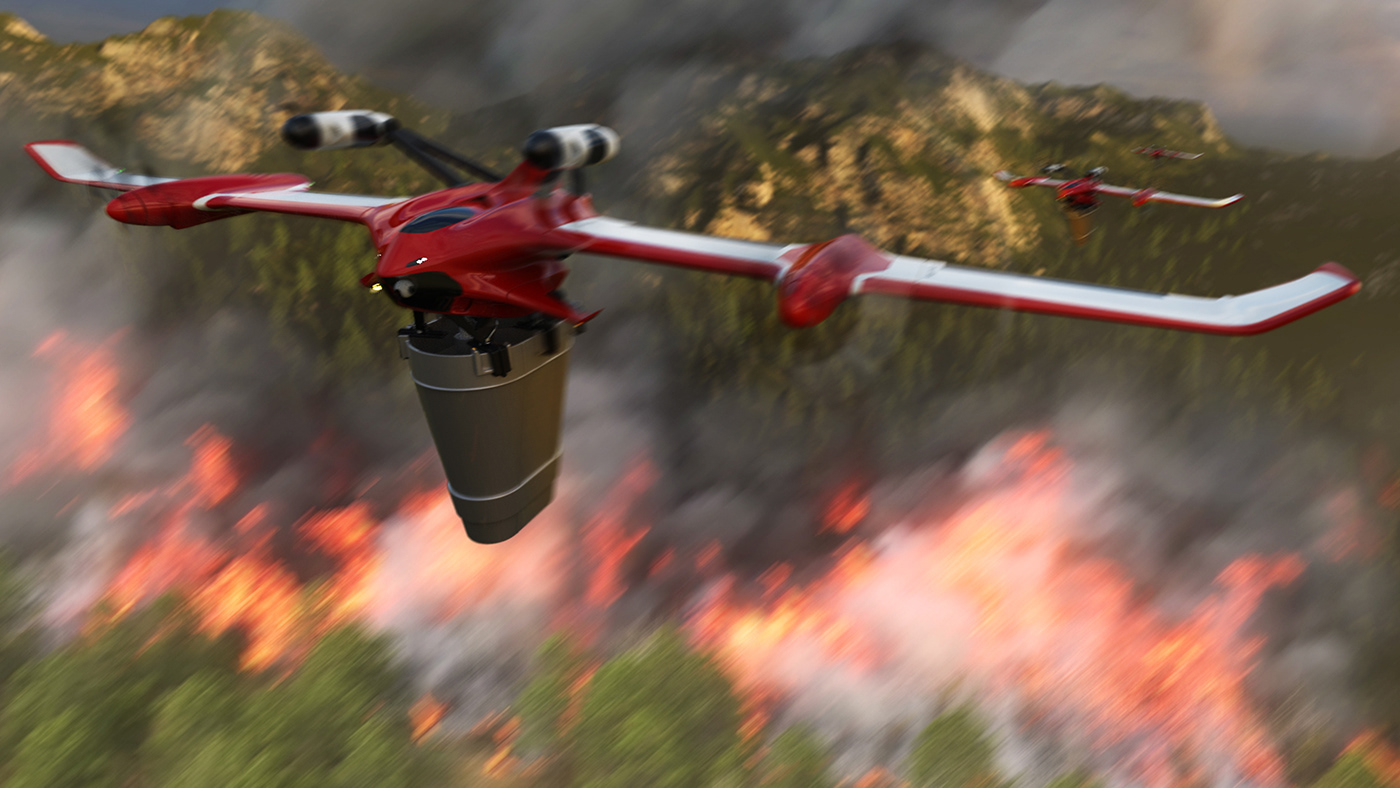
FIRELINE
Wildland Firefighting Drones

FireLine Falcon: Autonomous Firefighting Aircraft
The FireLine Falcon is a firefighting drone concept that uses swarm automation to contain wildfires.
Wildfires are threatening more people and property every year. Traditional aerial firefighting can be effective, however high operational costs, infrastructure requirements and the danger of night operations are major limitations.
The FireLine system leverages a continuous flow of tilt-wing drones to “keep wildfires small”. FireLine drones are cheaper than helicopters or planes, can takeoff and land without airports and can be deployed remotely, revolutionizing what effective wildand firefighting looks like.

01 Research – Understanding wildfires and wildland firefighting
Containing Wildfires: An Uphill Battle
The current approach to battling wildfires is a combination of ground crews and aerial firefighting. However, our resources are spread thin: uncertainty of where a fire may break out coupled with limited accessibility can delay response times, increase cost and increase danger for both ground and air forces. Wildfires grow at an exponential rate, therefore the best window to contain them is within the first 24 hours.
To create an effective solution, I would need to design a system that can respond rapidly and continuously to new fires until they are completely contained.



02 Design – Mood and inspiration board


03 Design – Focusing on the best solution
Aerial Attack: Keeping Wildfires Small
Recent advances in flight control technology for multi-rotor craft have created a new opportunity for aerial firefighting: VTOL drones.
Benchmarking against the capabilities of existing firefighting aircraft, VTOL drones fit an appealing mix of operational versatility: requiring minimal infrastructure, remote operation and the ability to target fires with high accuracy. For the best drone design for the job, my approach was to find the intersection of three factors: cargo capacity, speed to the fire and flight range.
The target parameters were a payload of 75 gallons of Phos-Chek (675 lbs), airspeed of
100 mph, and 200 miles of range before refueling with a minimal lift of 1,500 lbs.
100 mph, and 200 miles of range before refueling with a minimal lift of 1,500 lbs.

04 Design – Engineering and form development
Design Convergence: Bringing Form and Function Together
My design approach centered around the two most massive components, a 600cc motorcycle engine and a 75 gallon bucket. Using these elements as hard points, I was inspired from birds of prey to sculpt aerodynamic surfaces around them. Additional functional cosniderations were: minimal footprint when stowed on a truck and maximal lift generation when airborne.



05 Design – Final form and features
Introducing the Falcon
The final design is a vertical takeoff and landing drone with folding wings, swappable cargo buckets and thermal imaging cameras. The Falcon is powered by a hybrid 600cc engine and eight electric propellers for maximum range and minimum cycle time between phos-chek drops.
Remotely piloted with autonomous capability, these drones are designed to launch from wildland highways to keep firefighters safe and wildfires small.



06 System – The FireLine system in action
Wildfire Drill: Running Through a Typical Scenario
The FireLine system is designed to be flexible with fire behavior, however much of a wildfire progression follows a typical scenario. When a wildfire breaks out. the key system steps are: rapidly establishing a forward operating base on wildland highways, launching a continuous line of drones and re-supplying them after each round-trip flight until the fire is contained.



View more at: https://sagarsahoo.design/portfolio-item/fireline/



